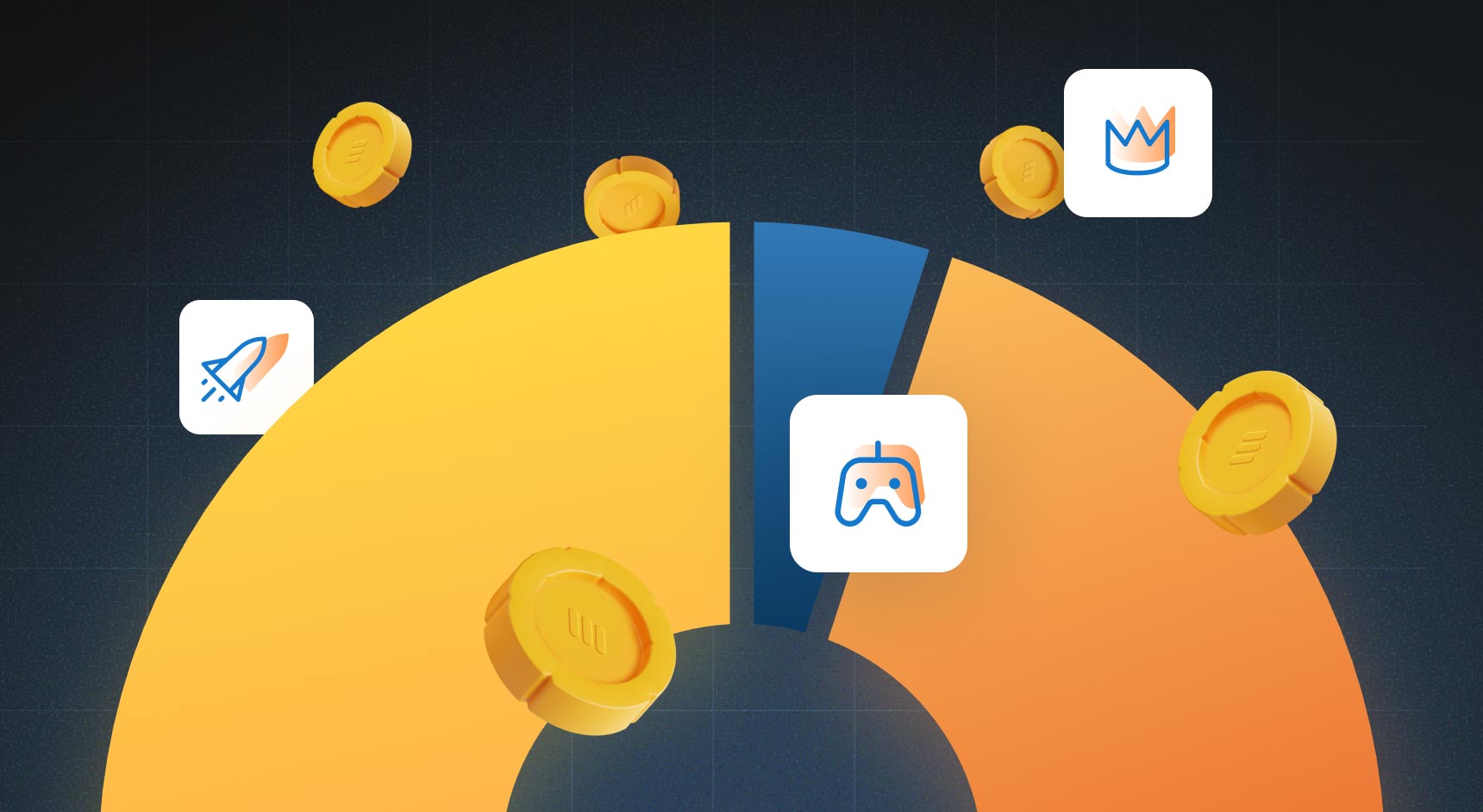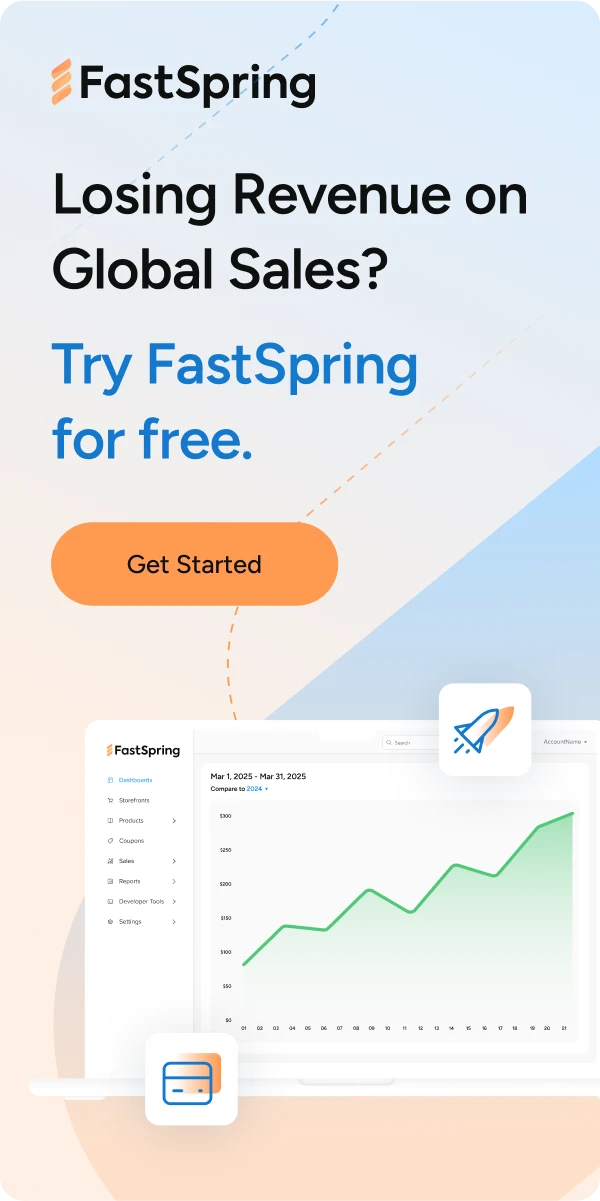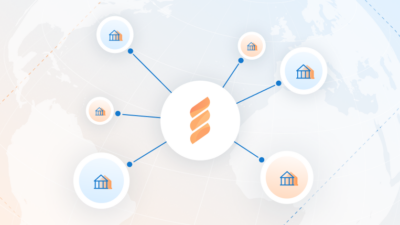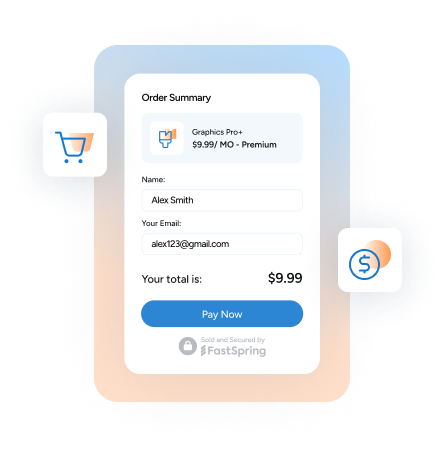Gaming D2C Is On the Table for Every Industry Insider We Surveyed, If Not Already in Use
FastSpring recently partnered with Omdia — sibling company to GDC and GameDeveloper.com — to survey over 100 highly targeted and qualified gaming industry executives about their monetization models and strategies.
Every single one of them was either already using a direct-to-consumer monetization model or at least considering it.
Most of those who aren’t already using it intend to adopt it within the next 12 months.
Here’s what gaming industry pros are doing to take their games’ monetization strategies into the future.
Read on to learn:
- Details about who we surveyed.
- Part 1: What we learned from the overall group.
- Part 2: Why and how the D2C crowd is already doing it.
- Part 3: What the Not-Yet-Doing-D2C crowd is considering.
- How FastSpring can help you implement D2C.
FastSpring is how gaming publishers sell in more places around the world. For over two decades, FastSpring has been a trusted payment provider you can use to sell games or in-game items on your website, web shop, or embedded directly into your game with fully customizable and branded checkouts just for you. FastSpring allows you to offload the complexity of global payments, sales tax and VAT compliance, player payments support, and many other aspects of payments management. Spend less time managing your payments and compliance and more time making great games! To learn more about how FastSpring supports game developers, visit fastspring.gg.
Who We Surveyed
In July through Aug. 2025, Omdia and FastSpring surveyed gaming industry leaders about their approaches to — and perceptions of — direct-to-consumer monetization.
Here are the details on who we included in the below data.
Their Roles and Functions
Of the 105 video game pros surveyed, 45% are senior executives, 25% are C-suite execs, 20% are directors, and 10% are senior managers.
The primary job functions of respondents include 46% leadership/management, 25% business development, 14% DevOps, 11% strategy, and 4% monetization.
Their Companies
Around half of respondents are at companies headquartered in the U.S., and half are at companies headquartered throughout Europe.
The size of companies represented spans a wide range of employee counts, with 43% working at companies with 500 people or more, 18% with 200-499 people, 33% with 100-199 people, and 6% with 20-99 people.
All companies represented have an annual revenue of at least USD 1 million, with 10% in the $1 million to $9.99 million range, 50% in the $10 million to $99.99 million range, 31% in the $100 million to $499.99 million range, 8% in the $500 million to $1 billion range, and 1% over $1 billion.
Their Games
When asked which platforms they develop games for (checking all that apply), 100% of respondents answered iOS, and 96% answered Android. Around a quarter to a third of respondents develop games for PS5, Switch, web/browser, Xbox Series X/S, or VR. Less than 20% of respondents develop games for Xbox One, PS4, or Switch 2.
Respondents were also able to choose multiple options from a list of game genres they’re currently developing for. Driving/racing, simulation, RPG, shooter, or card games were each selected at a rate of around 30%-40%. Around 20% each are sports, strategy, or AR/location-based. Ten percent or less of the genres selected are lifestyle, arcade, casino, or puzzle games.
When asked which single market segment best describes the segment their current game belongs to, 34% said midcore, 30% said hybridcasual, 18% said casual, 10% said hardcore, and 7% said hypercasual.
Part 1: What We Learned About Games Monetization From 105 Gaming Industry Professionals
They Monetize Their Games in Many Ways
The video games industry leaders we polled were given a list of monetization methods and asked to select all that apply.
Almost two-thirds of respondents are using paid in-game items/content, in-game currency, and/or battle passes/in-game subscriptions.
Unsurprisingly, these top three monetization methods all work very well for D2C monetization: It’s easy for a player to purchase them directly from the publisher’s web store and then have access to the products back in the game via a linked account.
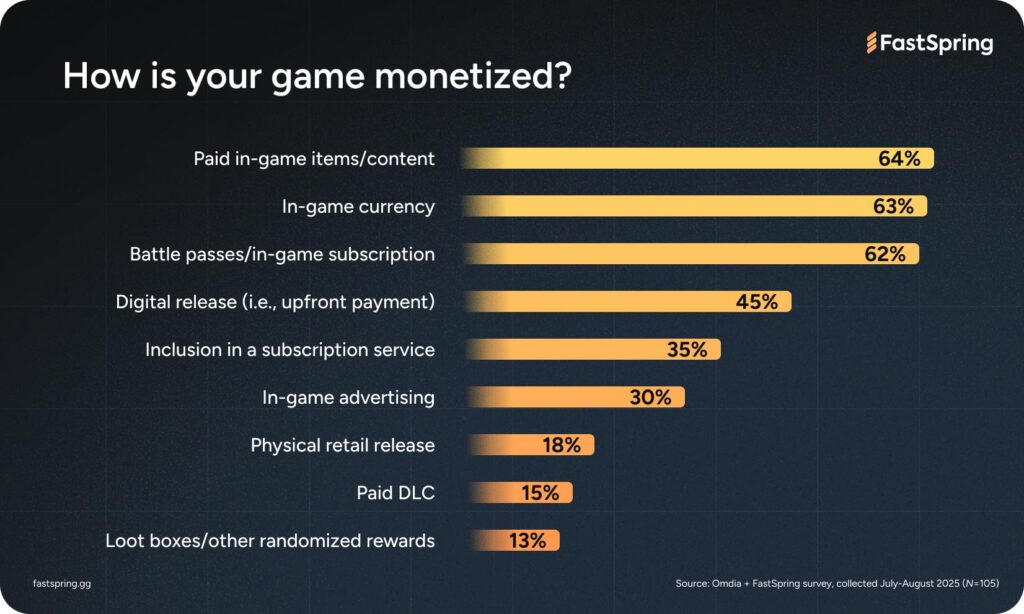
More moderately, digital releases (i.e., upfront payment) are used by 45% of those polled, inclusion in a subscription service is used by 35%, and in-game advertising is used by 30%. Much less frequently, only 18% are utilizing physical retail release, 15% paid DLC, and 13% loot boxes/other randomized rewards.
More Than Half Are Already Doing D2C
While the direct-to-consumer monetization model may still seem nascent to some, it has spread quickly across the gaming industry.
Of the 105 gaming leaders we surveyed, 57% are already doing D2C.
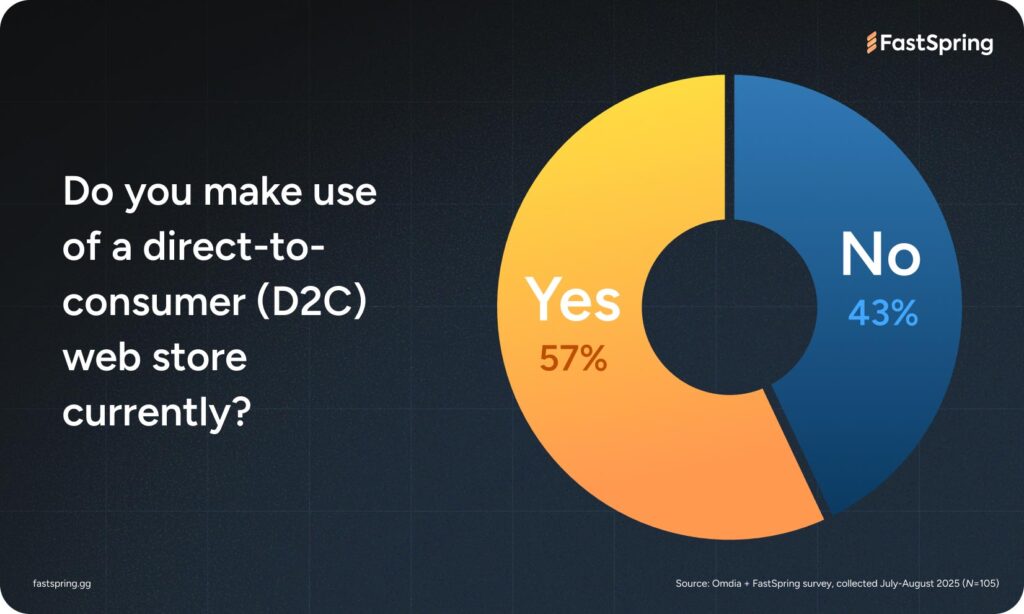
(Check out more detailed insights from each of these segments in Part 2 [doing D2C] and Part 3 [not yet doing D2C] below.)
We expect to see that percentage climb quickly — not only because of continually developing industry news related to marketplaces opening up more to D2C around the world, but also because that’s what the industry leaders are telling us they’re planning to do.
Nearly All Who Aren’t Doing D2C Yet Are Planning To
Of the 43% of respondents who haven’t yet implemented a D2C monetization method, 96% of them are planning to — 60% of them within the next 12mo.
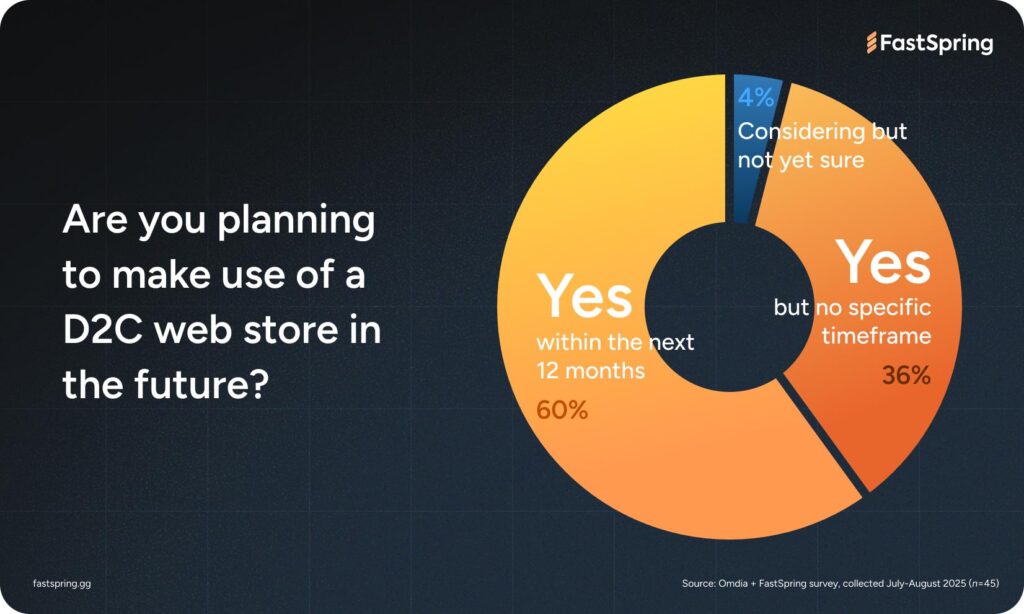
Thirty-six percent said they’re planning to, but they have no specific timeframe yet for implementation.
Only 4% said Considering but not yet sure.
To further clarify, there were response options of “No plans currently” or “Don’t know,” but zero respondents selected either of those answers.
What does this all mean?
Every leader we surveyed is considering investing in D2C, if they don’t have it set up already.
That Means = 98% of Industry Leaders Are Either Already Doing D2C or Planning To
When we combine the group of respondents who are already using D2C for their games, with the group of those who are planning to start (with or without a timeline), 98% of all respondents are planning for D2C.
And if you limit that group to those already using D2C (assuming they continue using it) and those who have a plan to start using it within 12 months, 83% of all those surveyed are saying they will be using D2C a year from now.
Will you be?
If your game doesn’t yet offer a way for players to make purchases directly — or if you don’t at least have a plan in place to offer it soon — you are putting yourself at a competitive disadvantage.
Or, at the very least, you may be missing out on extra revenue.
Here’s more information on how and why many industry leaders are already offering D2C purchasing.
Part 2: Why and How the D2C Crowd Is Already Doing It
There Are Varied Reasons to Implement D2C Monetization
There are a lot of great reasons to include D2C in your game’s monetization strategy — and you may be surprised by the top reasons industry leaders said they’re doing it.
Respondents were shown five randomized options and could also enter their own answer. We asked them to pick (or enter) their top three reasons for adopting a D2C web store.
There was no clear winner, with all five options receiving 43%-63% of the selections made. (No unique entries were submitted.)
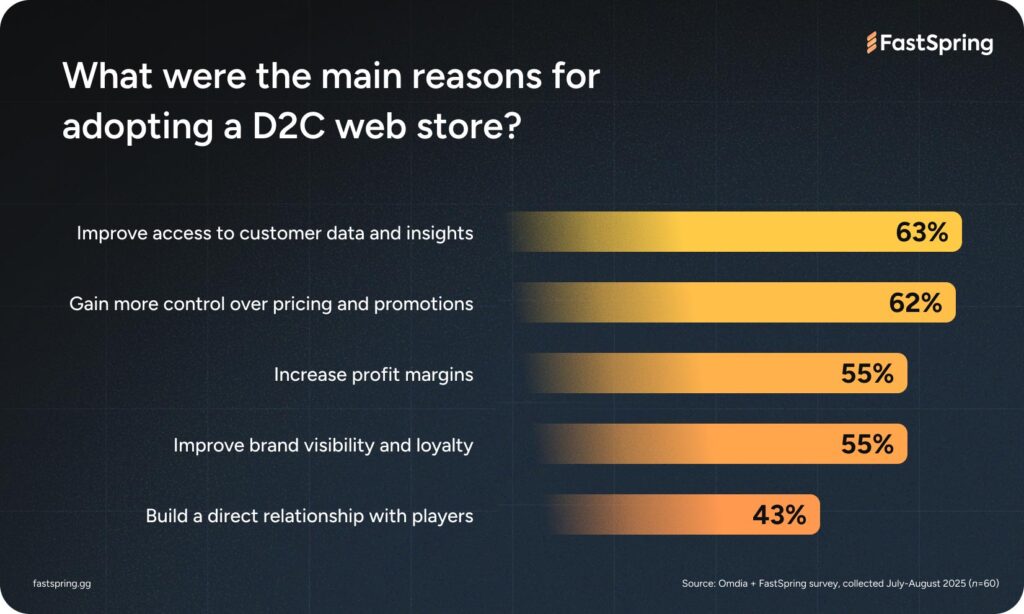
However, the spread of answers was slightly different from what we were expecting. While increasing profit margins is a great reason to have a web store for your game, it fell solidly in the middle of answers at 55%, equal to improving brand visibility and loyalty.
Higher on the list, respondents said they were most concerned with improving access to customer data and insights (63%) as well as gaining more control over pricing and promotions (62%).
Building a direct relationship with players was the least selected reason, but it still received 43% of selections.
All of this suggests that the reasons industry leaders invest in a D2C setup can differ for each game or company, but each one is still relatively common as a motivator.
Court Cases Compel Them
While there are specific internal drivers leading any given gaming publisher or games developer to want a D2C web shop for a game, there are also external motivators that open the doors and make it even more compelling.
We asked the 60 respondents who are already running D2C web stores if the recent Epic Games v. Apple court ruling on the U.S. App Store caused them to increase their investment in D2C.
And 95% of respondents said yes.
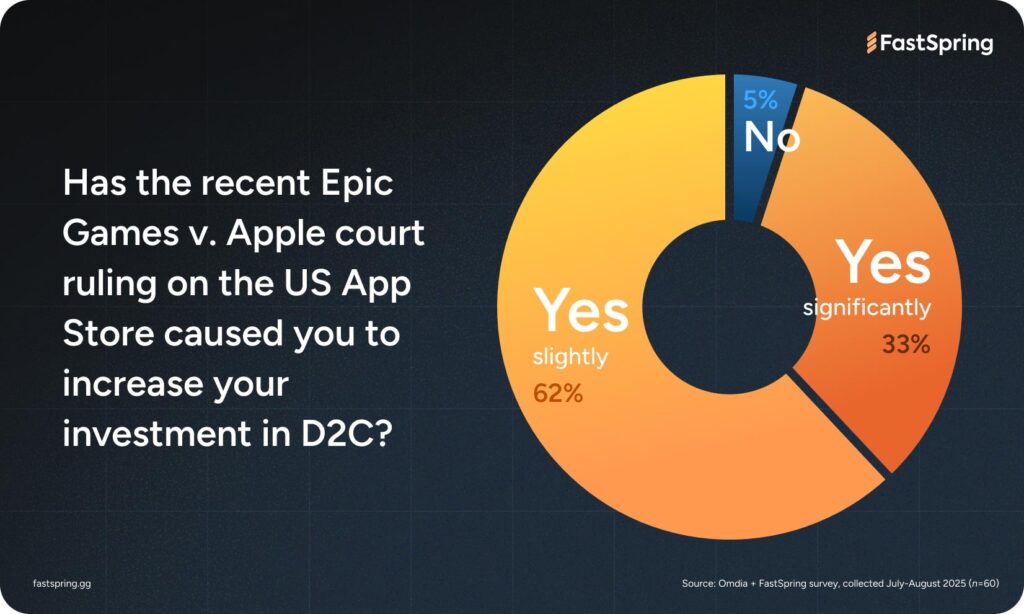
Only 5% said no.
To better gauge gaming decision makers’ clarity around international D2C legal developments, we asked all 105 respondents how confident they are in understanding the ongoing legal rulings and policies regarding D2C. We specifically mentioned the Epic Games v. Apple ruling in the U.S., the Digital Markets Act (DMA) in the EU, the Smartphone Act in Japan, and “etc.”
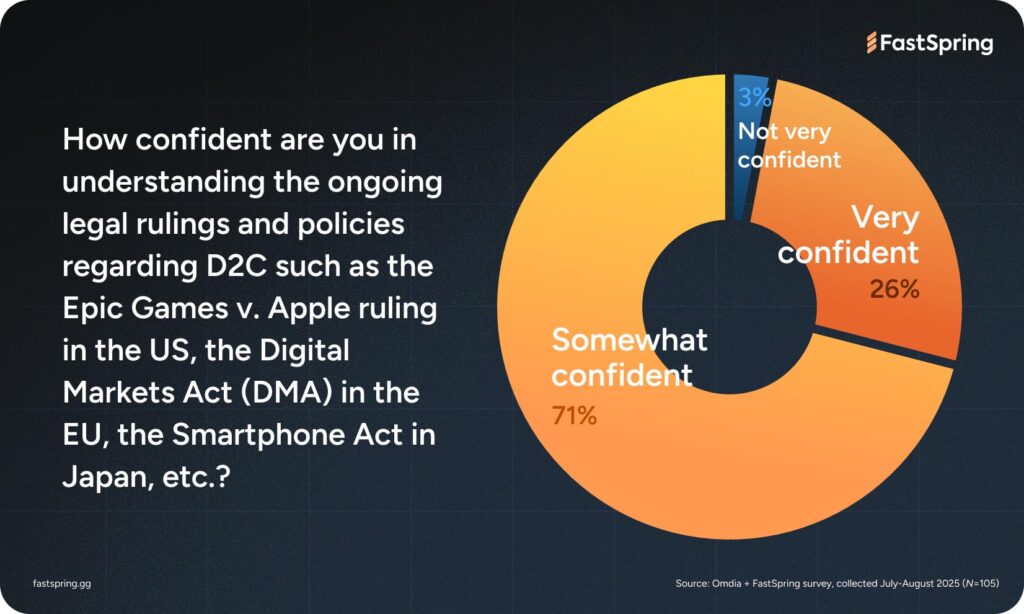
While 97% said they have some level of confidence around the topic, this question has much more nuanced answers than the previous one, with only 26% being very confident, but the majority at 71% saying they are “somewhat confident.” Only 3% said they are not very confident.
We feature even more mobile and gaming industry news on our blog, including news about Japan’s Mobile Software Competition Act Guidelines, Brazil calling for Apple to allow steering, the European Commission fining Apple for preventing steering, the Epic Games antitrust case against Google in the U.S., and more. Visit our Industry News archive for more articles.
They’re Using Steering, and They’re All Promoting It In App
Steering is generally defined as sending players from your game or mobile app to somewhere off platform where they can make a purchase, and there are really only three different approaches to D2C steering.
The vast majority (98%) of industry leaders polled are using steering in some manner.
Almost two-thirds say they are allowing players to navigate directly from their app to the game’s web store.
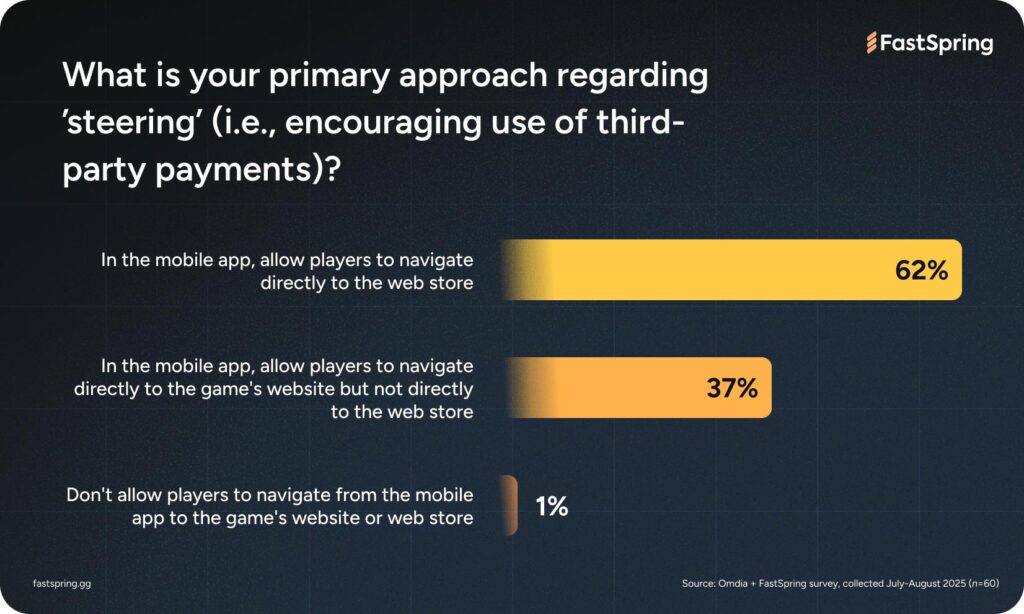
A little over one-third are utilizing a more indirect approach, allowing players to navigate from the mobile app to the game’s website, but not directly to the web store. Only one respondent said they are not allowing players to navigate from the mobile app to the website or web store.
We also asked how they’re approaching messaging around steering and the use of third-party payments.
Most commonly, 72% are promoting in app the ability to purchase via web store, and they’re explicitly mentioning price benefits. Only 28% are promoting their web store in app without explicitly mentioning price benefits.
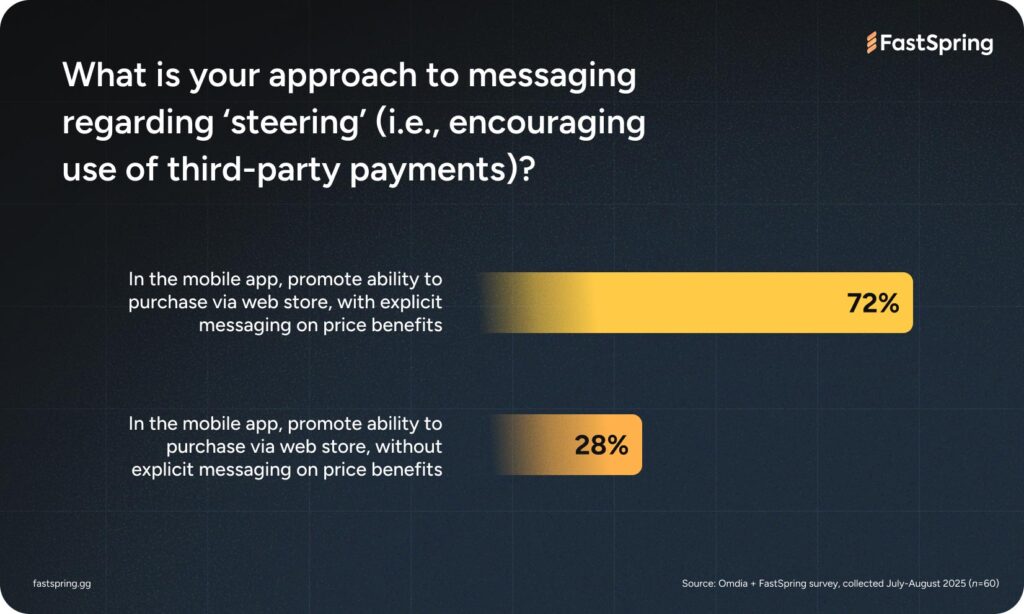
Additional choices were offered for this question, but no one selected “Allow purchases via web store with no messaging in the mobile app” or “Don’t know.”
It’s clear that just having the incentive to purchase via D2C channels is not enough. Publishers are seeing success from messaging that explains that benefit to their players, and that’s why recent rulings have been so impactful. We can now be more transparent than ever before with our players about the benefits of purchasing D2C, and that is unlocking unprecedented growth.
Revenue Share From D2C Is Significant — and Increasing
To learn more about D2C revenue, we asked respondents how much of their overall revenue is being driven by D2C, and how the share of overall revenue from D2C has changed in the last 12 months.
Note: We asked general revenue percentage questions for publishers’ revenue across their full catalog of games, not for individual games’ revenue. Had individual games been included, we expect the distribution would have been broader with games reaching much higher percentages.
Regarding what percentage of overall revenue is driven by D2C, all answers landed somewhere between 5% and 49% (no one selected less than 5% or more than 50%), with the vast majority landing somewhere between 10%-29% of revenue.
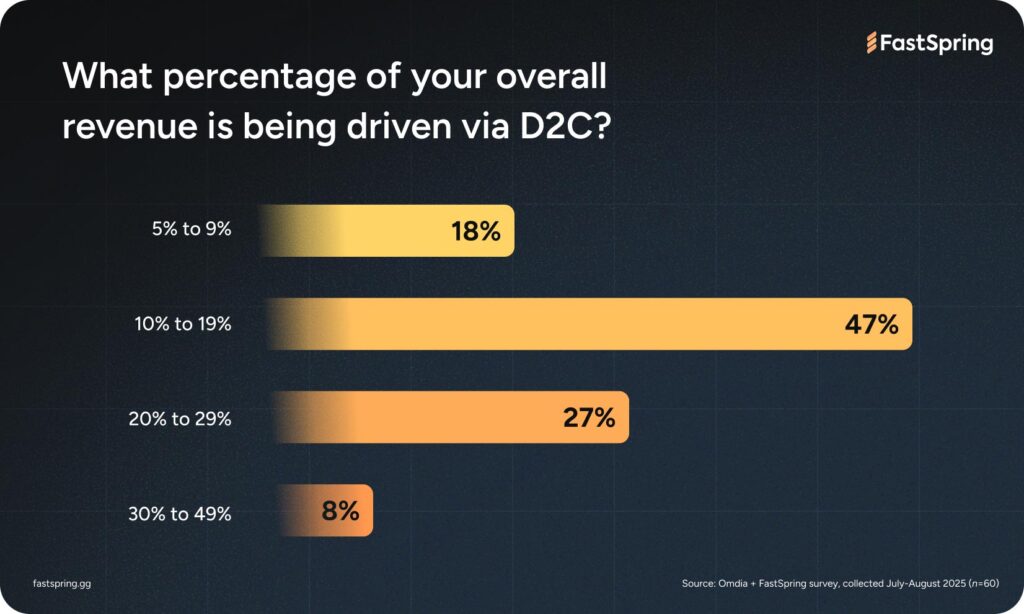
Although the smallest group of respondents said that 30%-49% of their revenue is thanks to D2C, it’s a testament to the powerful potential of a strong web store strategy that such a huge stream of revenue can flow through a channel with much lower fees than traditional app marketplaces.
We asked Justin Sacks of Nexus whether mobile games can really achieve >50% of their revenue from D2C. Listen to or watch his answer on Justin’s episode of our Growth Stage podcast.
Regarding how the share of revenue from D2C may have changed in the last year, 65% of respondents said it has somewhat increased, with 27% saying it has had little or no change.
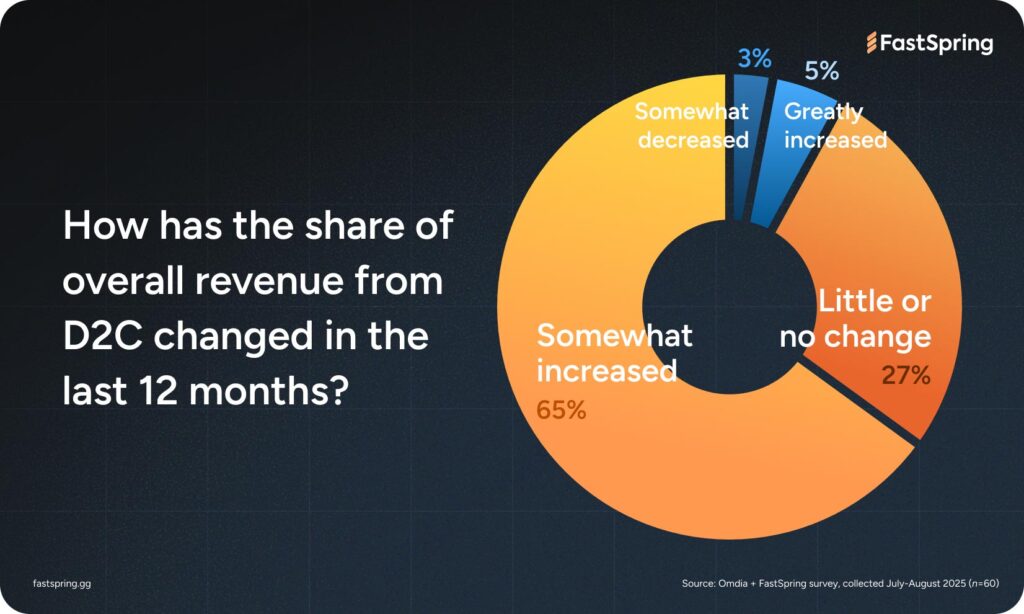
Only 3% have seen a slight decrease in the share of revenue from D2C, but 5% have seen it greatly increase. (No one responded that they have seen that share of revenue greatly decrease.)
All of this supports the idea that D2C is on an upward trajectory, with more potential now than ever before.
It also reaffirms that a successful D2C web store strategy can take a little time to take off — but once it does, publishers can see great increases in revenue share from D2C.
And when that revenue share is moving through channels with lower costs of operation, publishers get to keep more and more of it.
How They Manage Web Shops and Payments
Because there are a few “moving parts” to the D2C revenue machine, we asked respondents a few questions about the operations behind their web stores.
When asked which department is primarily responsible for managing their D2C web store, the IT and monetization departments were each selected for 28%. Marketing was next often selected at 22%, and business development manages web stores 18% of the time.
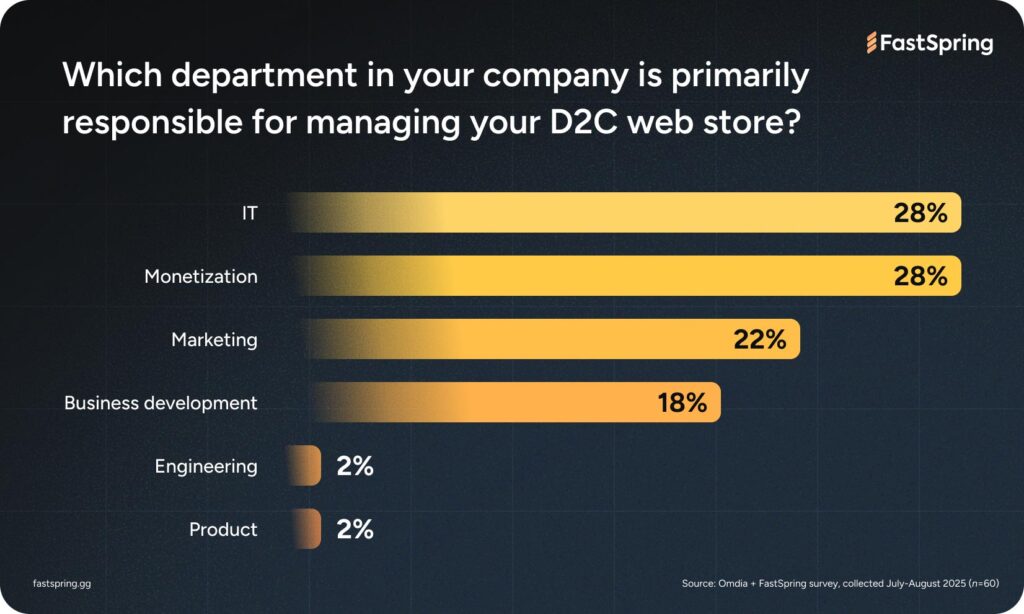
When asked if web development was handled by an internal dev team, freelancers/contractors, or an external agency, survey participants were able to select all that apply.
Results showed that 82% have an internal development team, 38% use freelancers and/or contractors, and another 38% use an external agency to handle web development.
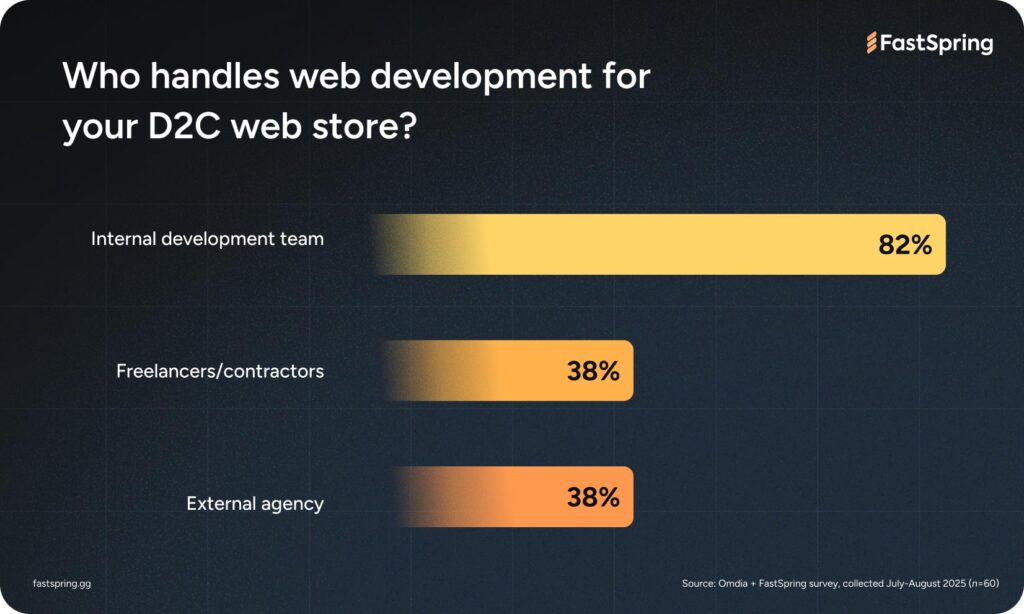
Between which department oversees it and who handles development, it’s clear there’s no singular solution for how to manage D2C. What makes sense for your studio may be different from the next. Consider the options here, and choose the framework that best suits your business.
For payment processing, we asked respondents to check all that apply from a randomized list of common payments options.
The majority of games industry leaders are using a games market specialist payment provider such as FastSpring to process payments for their D2C web store.

Also notable is that 90% of those surveyed are using two or more monetization methods, suggesting that most industry leaders are diversifying their monetization channels to capitalize on multiple revenue streams.
They’ve Overcome Worthwhile Challenges
Finally, we also asked this group of survey participants to select the top three challenges they had to overcome when they implemented a D2C web store. Results here were a little more evenly distributed, with no clear top answer.
The answers selected a little more commonly than others include payment processing and fraud prevention (57%), the technical complexity of integration (55%), legal and regulatory compliance (53%), and difficulty in driving traffic to the store (48%).
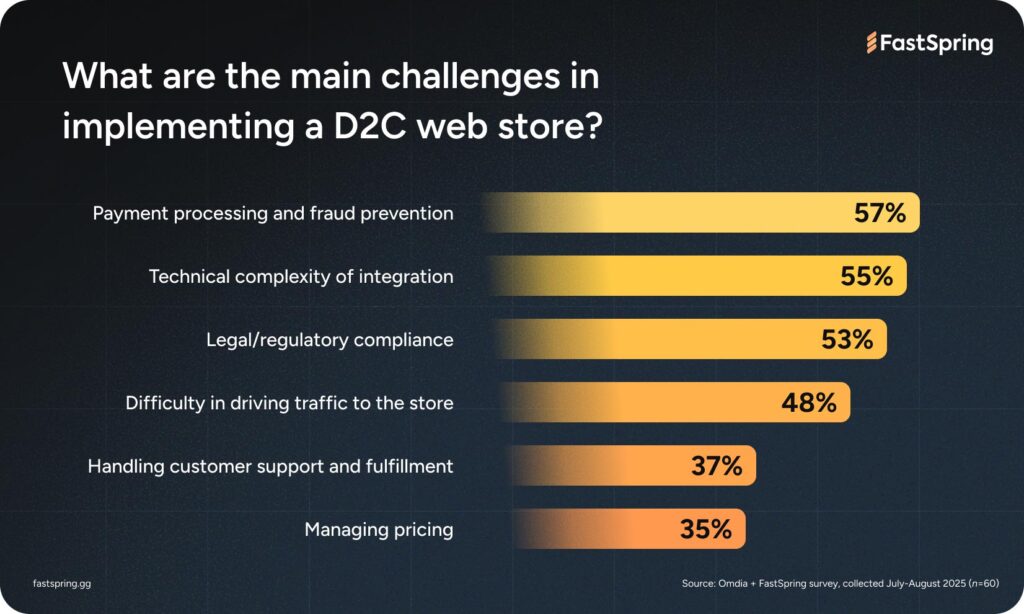
Selected a little less commonly were the need to handle customer support and fulfillment (37%) and managing pricing (35%).
All of these are valid challenges that should be considered before implementing a D2C payment platform.
But at the same time, they shouldn’t be viewed as insurmountable blockers, because the revenue growth from D2C is substantial, and the challenges can be overcome.
Not only that, but a merchant of record such as FastSpring can easily and affordably handle most of these challenges for you (more on that below), and we take pride in doing so.
FastSpring allows you to offload the complexity of global payments, sales tax and VAT compliance, player payments support, and many other aspects of payments management. Choose A Partner You Can Trust With Your Players™, and spend less time managing your payments and compliance, and more time making great games! To learn more about how FastSpring supports game developers, visit fastspring.gg.
Part 3: What the Not-Yet-Doing-D2C Crowd Is Considering
For those who haven’t yet implemented D2C, there’s a lot to consider regarding whether, how, and when they might do so. Here’s what real industry leaders are thinking about when weighing their options.
They Have Concerns — and Maybe Some Misconceptions — About Implementing D2C
Technical complexity is the top reason (67%) that gaming industry execs give for not yet implementing a D2C web store for their game(s).
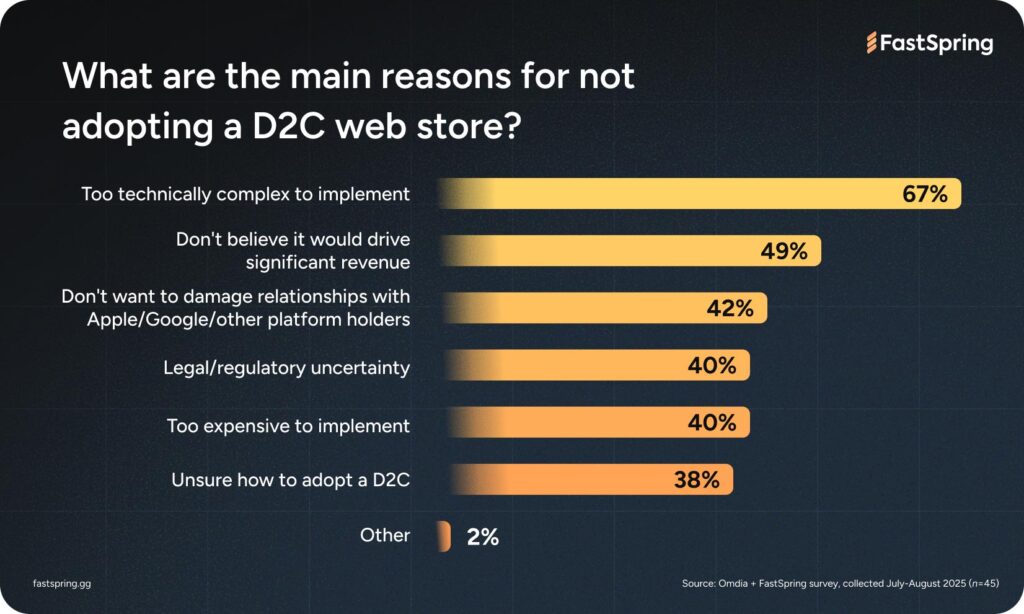
We asked them to select their top three reasons, and while two-thirds selected technical complexity, the rest of the options were mixed, with 49% not believing it would drive significant revenue, 42% not wanting to damage their relationship with platform holders such as Apple or Google, 40% having legal or regulatory uncertainty, 40% thinking it would be too expensive to implement, and 38% being unsure of how to adopt a D2C monetization method.
It’s interesting that the second most selected reason for not implementing D2C — selected by about half of this segment of respondents — is not believing that it will drive significant revenue. Considering that we’ve learned from industry leaders who are already doing D2C that anywhere from 5%-49% of their overall revenue is being driven by D2C — and that 70% of that group also says the share of their revenue from D2C is increasing — it seems this belief is a misconception.
96% Do Plan to Implement D2C
We already mentioned this above in Part 1, but of those who aren’t yet doing D2C, 96% of them are planning to at some point. More specifically, 60% of them are planning to implement something within the next 12 months.
To reiterate, if we assume that those already doing D2C will still be doing it in 12 months, and we assume that those planning to start within 12 months follow through with their plans, that means that at least 83% of all respondents will have D2C implemented and in use within 12 months.
96% Are Motivated by Recent Rulings
Much like those who have already implemented a D2C monetization method, court rulings are also affecting the decisions of those who haven’t yet implemented it.
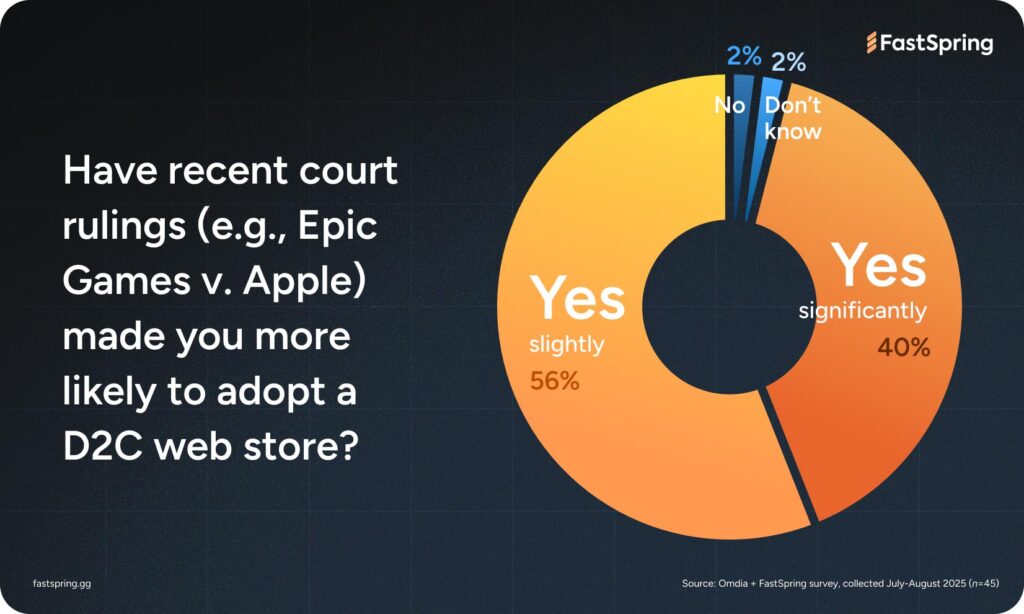
Almost all respondents said that yes, court rulings are making them more likely to adopt D2C, with 56% selecting “Yes, slightly,” and 40% selecting “Yes significantly.”
Recent court rulings are clearly influencing the rapid adoption of D2C methods. We expect these rulings to continue to evolve and drive even greater adoption of D2C monetization in the near future.
Visit our Industry News archive for more news and info about developing mobile steering regulations and rulings around the world.
How FastSpring Can Help You Implement D2C
Many indie and AAA publishers have already chosen FastSpring as their merchant of record and partner for global D2C payments. We bring more than 20 years of payments experience, flexible tools, and web shop features that ensure you’re able to monetize effectively without a pause in the player’s experience.

“As the landscape for video game ecommerce continues to evolve, it was clear that FastSpring was positioned to help maximize our pace and ambitions. On top of great service and a stellar team to work with, we truly love the simplicity the white label experience provides. It’s clear to players that they can trust our web shop checkout experience without additional hurdles or friction.”
– Stefan Ramirez, COO, Starform
Here’s how FastSpring can help you easily offer direct-to-consumer payment options to your players.
Steer From In App to Web and Back in Seconds With Steer Safe™
For mobile publishers in the U.S. (and wherever else in-app steering is allowed), we offer the ability to steer players from in-game experiences to a secure, localized web checkout and back to the game — all in a matter of seconds.
With our backend-agnostic Steer Safe™ buttons-and-links approach, you can easily add purchase buttons directly in game and securely pass player, product, and other relevant information from your backend of choice to your FastSpring powered checkout on the web to complete the purchase journey.
Then once players have made the purchase, they can be sent straight back to the app via deep link in the fastest, least-taps path possible.
Already Have a Web Store? Integration Is Easy
FastSpring is built to support publishers who are already doing D2C via web stores or publishers who are getting started from the ground up.
Whether you’re looking to replace your existing payments solution or want an additional payments partner to help if an issue arises with your existing partner(s), FastSpring’s here for you.
Integration with FastSpring can be as simple as a few lines of JavaScript code — or it can be as flexible as tailor-made webhooks firing on checkout completion, APIs to inform changes to player accounts, and much more.
The FastSpring solution is built from the ground up with modularity in mind. Instead of bringing in a prescriptive approach, FastSpring partners with you to ensure that you maintain control over the player purchase journey and your web store experience — all while still maintaining global compliance.
Get a Professionally Designed Web Store Customized for Your Games
Sometimes, you just don’t have the developers to stand up your own bespoke web store.
With FastSpring, that’s no problem.
In partnership with Nexus, get a professionally designed, optimized, and hosted web store built for you — without setup or professional service fees.
You’ll also avoid DIY web store wizards that make you do all the work. Instead, get your own custom web store that’s fully integrated with FastSpring with no integration work required from your team.
We allow your players to pay with their payment method, language, and currency of choice, and we include our advanced fraud prevention tailor-made for gaming customers. Plus, when you’re ready to take the reins, transitioning to your bespoke web store is simple.
Partner With FastSpring
For over two decades, FastSpring has been a trusted payment provider you can use to sell games or in-game items on your website, web shop, or embedded directly into your game with fully customizable and branded checkouts just for you.
Partnering with FastSpring allows you to offload the complexity of global payments, sales tax and VAT compliance, player payments support, and many other aspects of payments management.
Choose A Partner You Can Trust With Your Players™. Spend less time managing your payments and compliance and more time making great games!
To learn more about how FastSpring supports game developers, visit fastspring.gg.
Or, if you’re ready to see more now, schedule some time with our Solution Engineers or sign up to check out our platform for yourself.
Learn more about our partner on this project, Omdia, at https://omdia.tech.informa.com/.




